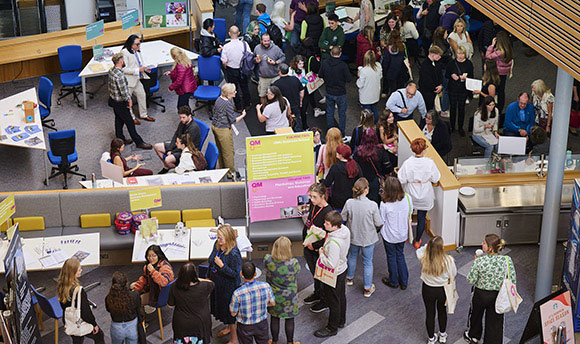QMU Net-Zero Strategy: Context
Context
Drivers
Scottish Government legislation requires a societal wide reduction in greenhouse gas emissions of 100% (relative to 1990 levels) by 2045 to achieve the UN goal of reducing global warming to no more than 1.5°C above pre-industrial levels. Interim targets of a 75% reduction by 2030 and 90% by 2045 have also been set.
Public bodies in Scotland are required to set a target date for achieving net-zero in their annual reports through the Climate Change (Duties of Public Bodies: Reporting Requirements) (Scotland) Amendment Order 2020. This includes information on how the organisation will align spending plans and resources to deliver emission targets.
The Scottish Government have also set increasing ambitious targets as part of their programme for government, bringing forward the date to achieve net-zero to 2038 in the public sector.
To support our commitment, the University has signed up to the UN global back campaign ‘Race to Zero’ and will align with Science Based Targets to ensure transparency and accountability in target setting and reporting of progress.
History
The University made its first significant contribution to climate change action with the move to a new sustainably designed and delivered campus in 2007. This was recognised through accreditation to BREEAM Excellent and CEEQUAL standards. This relocation reduced our annual operational carbon emissions by 38% from the previous estate.
Underlining our holistic approach to sustainability, Climate Change plans have been in place since 2010 and the University was an original signatory to the University Climate Change Commitment for Scotland (UCCCfS).
The location for the University also reflected the opportunities that the development of the first higher education institution within the East Lothian area could enable, working alongside the local community of Musselburgh.
We have built on these links and partnership and engagement locally continues to grow and future growth around us offers the opportunity to ensure that we embrace and influence positive and sustainable outcomes.
Growth and Future Development
To deliver the objectives of this strategy, the University needs to be able to do this from a position of financial sustainability.
Our Strategic Plan implementation projects planned growth in student numbers to circa 5000 FTE on the campus in the period to 2027 as well as growth in online learning and transnational partnerships. The planned growth in the student numbers in that period does not anticipate any increase in the physical footprint of the campus estate or buildings., however the impact of any future growth of estate would need to be considered in terms of impact on the trajectory to achieve net-zero.
A joint venture company with East Lothian Council will deliver a new hub building with 7200m2 innovation space by 2025. The building will be let commercially. Appropriate elements will be accounted for in the University emissions reporting in line with controlling financial interests when it becomes operational.
A commercial and community zone is proposed to be developed by the University with potential for occupation by university activities and commercial tenants. As the masterplan develops, the impacts on net-zero will be modelled.
Where new buildings are to be delivered, these will be briefed to ensure that they minimise as far as practical the embodied carbon through their construction and incorporate measures to ensure that they achieve an earlier operational net-zero date than existing buildings.
A sustainable development policy will be created to underpin this commitment drawing on work undertaken in the early stages of the Innovation Hub. This will address the potential for connections to the wider district heating network, lower operational energy benchmarks, prioritisation of sustainable transport and travel and opportunities for micro-renewables.
The policy will also cover the approaches to be taken in refurbishment projects within the existing estate ensuring that these align with the principals of the net-zero strategy and achieve a lower carbon impact.
Delivering Change
Irrespective of the tangible benefits that the University has previously delivered on, there is a need to recognise our approaches need to adapt and evolve as new opportunities, ideas and innovations drive a greater pace and scope of change needed to respond to the threats posed by climate change.
Equally the University is aware of the risks in seeing results measured only in carbon emissions reductions without consideration of the broader aspects of climate change and ensuring appropriate consideration of the social, economic as well as environmental impacts within its plans. We recognise climate change affects the social and environmental determinants of health – clean air, safe drinking water, sufficient food and secure shelter.
We will seek to enhance the role of the University as an actor of change through our learning, teaching and research in building climate change resilience, aiding adaptation and galvanising transformative action.
|
Case Study - Research: Informing Adaption Strategy |
|---|
|
Research: Informing Adaption Strategy
'informing adaptation strategy through mapping the dynamics linking climate change, health and other human systems: Case studies from Georgia Lebanon Mozambique, and Costa Rica' While scientific research supporting mitigation of further global temperature rise remains a major priority, CoP26 and CoP27 saw widespread recognition of the vital importance of research that informs adaptation to irreversible charges in climate and the increasing threats of extreme weather events. This study adopted systems dynamics to consider linkages between climate change and population health across four low- and middle-income country settings. We developed preliminary casual loop diagrams (CLD) addressing dynamics operating in Mozambique, were identified. System dynamics modelling methods, such as participatory group model building, can provide a valuable mechanism across multiple sectors to consider the development of adaptation strategies Institute for Global Health and Development 2021 |



